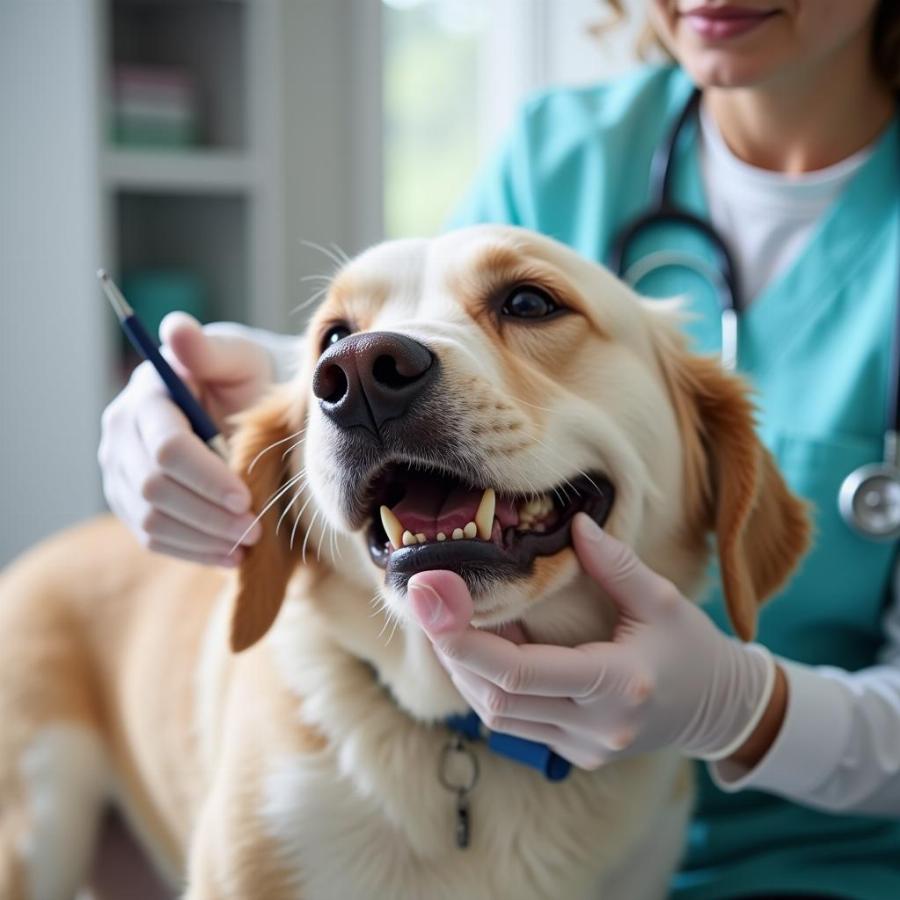Pale gums in dogs can be a cause for concern, signaling a potential underlying health issue. While not always an emergency, pale gums often indicate a disruption in your dog’s circulatory system and warrant immediate attention. This article provides a comprehensive guide to understanding pale gums in dogs, including the causes, symptoms, and what you should do if you notice this condition in your furry friend.
Understanding the Significance of Gum Color
A dog’s gum color can reveal a lot about their overall health. Healthy gums are typically a vibrant pink, similar to bubblegum. Pale gums, on the other hand, can appear white, gray, or even bluish. This change in color often signifies a decrease in blood flow and oxygen circulation. Recognizing this change is crucial for early detection and treatment of potential health problems.
What Causes Pale Gums in Dogs?
Several factors can contribute to pale gums in dogs, ranging from minor issues to serious medical conditions. Some of the most common causes include:
- Anemia: This condition is characterized by a decrease in red blood cells, which carry oxygen throughout the body. Different types of anemia exist, each with its own underlying cause.
- Internal Bleeding: Blood loss due to trauma, surgery, or certain medical conditions can lead to pale gums.
- Heart Disease: Heart conditions can impair blood flow, resulting in pale gums and other symptoms.
- Shock: Shock is a life-threatening condition that occurs when the body doesn’t receive enough blood flow. This can be caused by various factors such as trauma, severe allergic reactions, or infections.
- Dehydration: Lack of adequate fluids can also cause pale gums, as blood volume decreases.
- Hypothermia: A dangerously low body temperature can restrict blood flow to the extremities, including the gums.
- Toxins: Ingesting certain poisons can interfere with blood oxygenation, leading to pale gums.
- Autoimmune Diseases: Certain autoimmune diseases can attack red blood cells, contributing to anemia and pale gums.
Recognizing the Symptoms
Pale gums are often accompanied by other symptoms, which can help pinpoint the underlying cause. These include:
- Lethargy and weakness
- Rapid breathing
- Increased heart rate
- Cold extremities
- Loss of appetite
- Collapse
 Veterinarian Examining a Dog with Pale Gums
Veterinarian Examining a Dog with Pale Gums
What to Do if You Notice Pale Gums
If you notice your dog has pale gums, it’s crucial to seek immediate veterinary attention. Pale gums are a serious sign that shouldn’t be ignored. Your veterinarian will perform a thorough examination, including blood tests, to determine the underlying cause and recommend the appropriate treatment.
“Pale gums are a clear indicator that something isn’t right,” says Dr. Emily Carter, DVM. “The sooner you bring your dog in for an examination, the better the chances of a positive outcome.”
Home Care and Prevention
While you should never attempt to treat pale gums at home without veterinary guidance, some preventative measures can help maintain your dog’s overall health:
- Provide a Balanced Diet: Ensure your dog receives a nutritious diet appropriate for their age and breed.
- Regular Exercise: Regular physical activity promotes good circulation and overall well-being.
- Prevent Parasites: Parasites can cause anemia, so ensure your dog is on a preventative medication.
- Regular Veterinary Checkups: Routine checkups can help identify potential health problems early on.
When are Pale Gums an Emergency?
Pale gums are always a cause for concern and warrant a veterinary visit. However, if accompanied by symptoms like collapse, difficulty breathing, or uncontrolled bleeding, consider it an emergency and seek immediate veterinary care.
“Don’t hesitate to rush your dog to the nearest emergency veterinary clinic if you see signs of distress alongside pale gums,” advises Dr. David Miller, DVM. “Time is of the essence in these situations.”
Conclusion
Pale gums in dogs are a serious sign that should never be ignored. By understanding the potential causes, recognizing the accompanying symptoms, and seeking prompt veterinary care, you can help ensure your furry friend receives the necessary treatment and maintains a long, healthy life. Early detection and intervention are key to managing the underlying condition causing pale gums and ensuring a positive outcome for your dog.
FAQ
- What should normal dog gums look like? Healthy dog gums are typically a bright, bubblegum pink.
- Can dehydration cause pale gums? Yes, dehydration can cause pale gums as blood volume decreases.
- Are pale gums always a sign of a serious illness? While pale gums can indicate a serious issue, they can also be caused by less severe conditions. A veterinarian should always assess the situation.
- What tests will the vet perform to diagnose the cause of pale gums? Blood tests are commonly used to diagnose the underlying cause of pale gums.
- Can I treat pale gums at home? No, you should never attempt to treat pale gums at home without veterinary guidance.
Related Articles
Similar to dry heaves in dogs, pale gums can be an indicator of underlying health problems. This is also comparable to hookworm symptoms dog where immediate attention is crucial. For more information about anemia, a potential cause of pale gums, consider reading our article on immune-mediated hemolytic anemia in dogs. Understanding medication options like clopidogrel for dogs can also be helpful in certain situations. This relates to the importance of deworming pills for dogs for overall pet health.
Beaut Dogs: Your Trusted Source for Canine Information
Beaut Dogs is your go-to resource for all things canine, providing reliable and expert advice on the world of dogs. From breed information and care tips to health concerns, we’re here to support you on your journey as a dog owner. When you need expert advice, please contact us via Email: [email protected] for detailed and accurate information from Beaut Dogs.